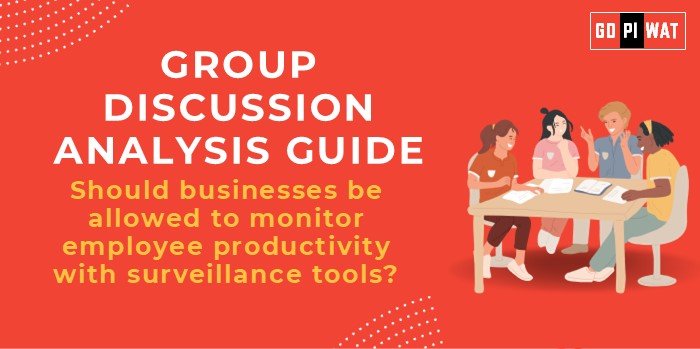📋 Group Discussion Analysis Guide
🌐 Topic: Should businesses be allowed to monitor employee productivity with surveillance tools?
💡 Introduction to Employee Productivity Monitoring
- Opening Context: With increasing work-from-home models post-pandemic, many businesses have turned to surveillance tools to track employee productivity. The rise of remote work has created a global debate on balancing corporate efficiency and employee privacy.
- Topic Background: Employee monitoring involves using surveillance tools such as time-tracking software, keystroke loggers, screen monitoring, and even webcam analytics. While businesses argue that these tools improve efficiency, critics highlight privacy concerns and trust erosion.
📊 Quick Facts and Key Statistics
- 🌍 Global Adoption: 60% of companies worldwide adopted employee monitoring tools post-2020 pandemic.
- 📈 Productivity Boost: Companies report a 30% rise in productivity using monitoring tools.
- ⚠️ Employee Pushback: A survey found that 73% of employees felt constant surveillance caused stress and reduced morale.
- ⚖️ Legal Boundaries: GDPR in the EU and state laws in the US regulate workplace monitoring to protect privacy.
- 🛠️ Tools in Demand: Popular tools include Time Doctor, Hubstaff, and Teramind.
👥 Stakeholders and Their Roles
- Businesses: Strive to optimize productivity and prevent “time theft” among employees.
- Employees: Seek autonomy, privacy, and trust in the workplace without invasive surveillance.
- Government/Legal Bodies: Regulate workplace surveillance to protect worker rights.
- Tech Companies: Provide advanced monitoring tools to meet business demands.
✅ Achievements and Challenges
Achievements:
- 📊 Productivity Gains: Companies using tracking tools report quantifiable increases in task completion and reduced idle time.
- 🔍 Reduced Fraud: Surveillance tools minimize workplace time theft or misuse of resources.
- 📈 Performance Evaluation: Tools provide clear data for employee performance reviews, benefiting goal setting.
Challenges:
- ⚠️ Employee Stress: Excessive monitoring can create distrust and negatively impact mental health.
- 📜 Ethical Concerns: The thin line between monitoring for productivity and invading privacy raises ethical debates.
- ⚖️ Legal Risks: Global laws on data protection challenge companies to monitor without breaching privacy regulations.
🌍 Global Comparisons
- 🇺🇸 United States: Tech-driven workplace monitoring is legal but varies by state.
- 🇪🇺 European Union: Stringent GDPR laws require transparency and consent for employee surveillance.
- 🇨🇳 China: Companies extensively monitor employees, citing productivity as a core focus.
📚 Structured Arguments for Discussion
- Supporting Stance: “Businesses must monitor productivity using surveillance tools to maintain efficiency and eliminate time theft, especially in remote setups.”
- Opposing Stance: “Employee surveillance leads to privacy violations, stress, and a breakdown in trust between employers and employees.”
- Balanced Perspective: “While monitoring productivity can enhance efficiency, businesses must implement tools ethically, with transparency and employee consent.”
💬 Effective Discussion Approaches
- Opening Approaches:
- 📊 Statistical Start: “Post-pandemic, 60% of companies globally adopted employee surveillance tools, claiming a 30% rise in productivity, but at what cost to employee well-being?”
- ❓ Question-Based Start: “Is it fair to trade employee privacy for workplace efficiency? How far should surveillance go?”
- Counter-Argument Handling:
- If challenged on privacy: “While privacy is crucial, a balanced approach with transparency and clear monitoring policies can address concerns.”
- Addressing productivity claims: “Productivity increases might occur, but at the risk of eroding morale and increasing stress, which can harm long-term results.”
🧐 Strategic Analysis of Strengths and Weaknesses
- Strengths: Improved productivity metrics, transparency in performance evaluations, prevention of fraud or time misuse.
- Weaknesses: Employee stress and mistrust, ethical and legal challenges, short-term efficiency gains over long-term loyalty.
- Opportunities: Ethical monitoring frameworks (e.g., partial tracking with consent), AI-based performance evaluation for unbiased feedback.
- Threats: Legal restrictions on workplace surveillance, employee pushback and attrition.
📖 Connecting with B-School Applications
- Real-World Applications:
- Operations Management: Case studies on optimizing productivity through ethical monitoring practices.
- Human Resource Management: Balancing employee privacy with performance evaluation metrics.
- Sample Interview Questions:
- “What measures can businesses take to ensure ethical surveillance of employees?”
- “Discuss how employee trust impacts overall workplace productivity.”
- Insights for B-School Students:
- Ethical leadership in balancing productivity and employee autonomy.
- Understanding global laws on workplace privacy and corporate governance.


